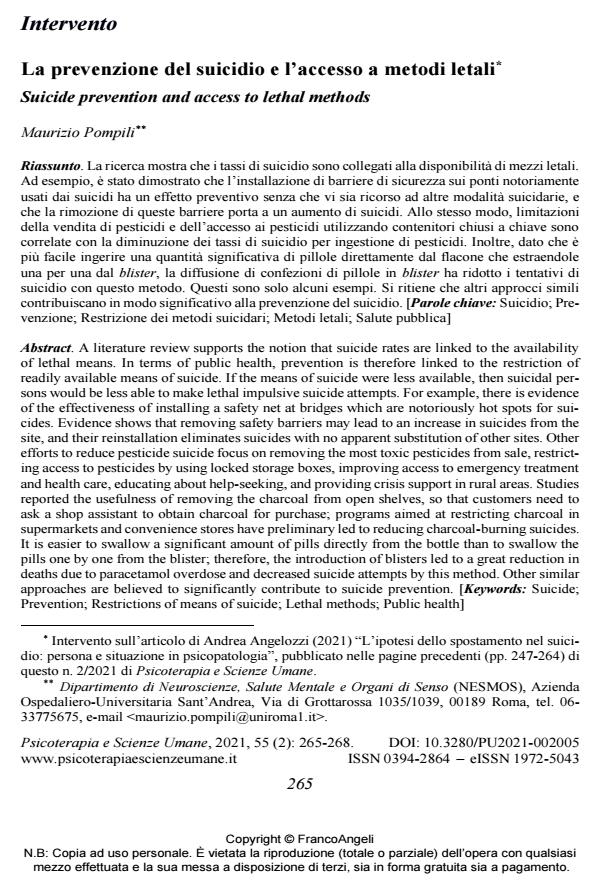Suicide prevention and access to lethal methods
Journal title PSICOTERAPIA E SCIENZE UMANE
Author/s Maurizio Pompili
Publishing Year 2021 Issue 2021/2
Language Italian Pages 4 P. 265-268 File size 337 KB
DOI 10.3280/PU2021-002005
DOI is like a bar code for intellectual property: to have more infomation
click here
Below, you can see the article first page
If you want to buy this article in PDF format, you can do it, following the instructions to buy download credits

FrancoAngeli is member of Publishers International Linking Association, Inc (PILA), a not-for-profit association which run the CrossRef service enabling links to and from online scholarly content.
A literature review supports the notion that suicide rates are linked to the availability of lethal means. In terms of public health, prevention is therefore linked to the restriction of readily availa-ble means of suicide. If the means of suicide were less available, then suicidal persons would be less able to make lethal impulsive suicide attempts. For example, there is evidence of the effec-tiveness of installing a safety net at bridges which are notoriously hot spots for suicides. Evidence shows that removing safety barriers may lead to an increase in suicides from the site, and their reinstallation eliminates suicides with no apparent substitution of other sites. Other efforts to re-duce pesticide suicide focus on removing the most toxic pesticides from sale, restricting access to pesticides by using locked storage boxes, improving access to emergency treatment and health care, educating about help-seeking, and providing crisis support in rural areas. Studies reported the usefulness of removing the charcoal from open shelves, so that customers need to ask a shop assistant to obtain charcoal for purchase; programs aimed at restricting charcoal in supermarkets and convenience stores have preliminary led to reducing charcoal-burning suicides. It is easier to swallow a significant amount of pills directly from the bottle than to swallow the pills one by one from the blister; therefore, the introduction of blisters led to a great reduction in deaths due to pa-racetamol overdose and decreased suicide attempts by this method. Other similar approaches are believed to significantly contribute to suicide prevention.
Keywords: Prevention; Re-strictions of means of suicide; Lethal methods; Public health
Maurizio Pompili, Intervento. La prevenzione del suicidio e l’accesso a metodi letali in "PSICOTERAPIA E SCIENZE UMANE" 2/2021, pp 265-268, DOI: 10.3280/PU2021-002005